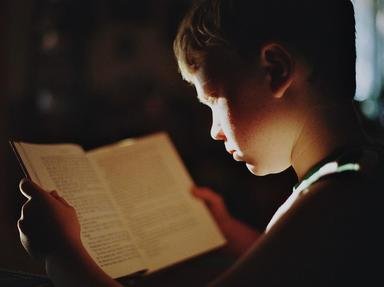Quiz Answer Key and Fun Facts
1. Mark Twain described the central character of this book as "the dearest and most lovable child in fiction since the immortal Alice." Which book was it?
2. One of my favourite authors wrote historical novels for young people. Which of these authors was it?
3. One of my favourite books when I was a youngster charted the progress of a foundling. The unfortunate protagonist was sold into virtual slavery, got involved with a ring of thieves, was arrested and tried, and escaped death at the hands of a sadistic bully before finding a loving home. Who was this unfortunate character?
4. Like most children in the UK in the 1940s and 1950s I read the books by this prolific British author of KidLit. She lived in a house called 'Green Hedges'. Who was she?
5. Very early on I fell in love with poetry, and took part in recitation competitions. When I was nine I won a competition reciting 'How They Brought the Good News (from Aix to Ghent)'. Who wrote this epic poem?
6. I spent my early childhood in Wales, and fell under the spell of the collection of Welsh myths and legends known as 'The Mabinogion'. In which Welsh town would one find the oldest manuscript of these tales?
7. Like most children I was fascinated by the stories about Robin Hood, and those of his Welsh counterpart. I was about ten when I read Llewelyn Pritchard's book about the 'Welsh Robin Hood'. What was his name?
8. In my early teens I discovered Jane Austen and I've read and re-read her books ever since. My favourite Austen novel tells the tale of the Dashwood family, and focuses primarily on the romantic entanglements of the two older daughters. Which novel is it?
9. Contemporary with Jane Austen was another of my favourite authors from my childhood, even though he did not write for children. The first book I read of his was 'Ivanhoe'. Who is the author?
10. My father always said that if I had nothing else to read, I'd settle for the labels on jam jars! I was about 13 when I read my first detective novel by this author who also wrote religious plays and produced religious programming for the BBC. Who is the author?
11. 'Puck of Pook's Hill' allowed me to combine my love of history and literature. Who wrote it?
12. Speaking of Puck, we all know that he is one of the leading characters in Shakespeare's 'A Midsummer Night's Dream'. My introduction to Shakespeare came in a book for children that distilled the plays into story form. I was seven or eight when I read it. Who wrote it?
13. My developing sense of humour was helped along when I was about 12 and read the hilarious record of a boating trip up the Thames. What was the name of this classic by Jerome K. Jerome?
14. When I lived in the UK I loved sailing. A character in one of my favourite books from those days (and even today) is quoted as saying "There is nothing - absolutely nothing - half so much worth doing as simply messing about in boats...or with boats...in or out of 'em, it doesn't matter." I heartily agree. In which book would you find the quote?
15. I was 15 when I read the detective novel that made a devoted Ricardian of me. Can you identify the book and the author?
Source: Author
Cymruambyth
This quiz was reviewed by FunTrivia editor
agony before going online.
Any errors found in FunTrivia content are routinely corrected through our feedback system.
